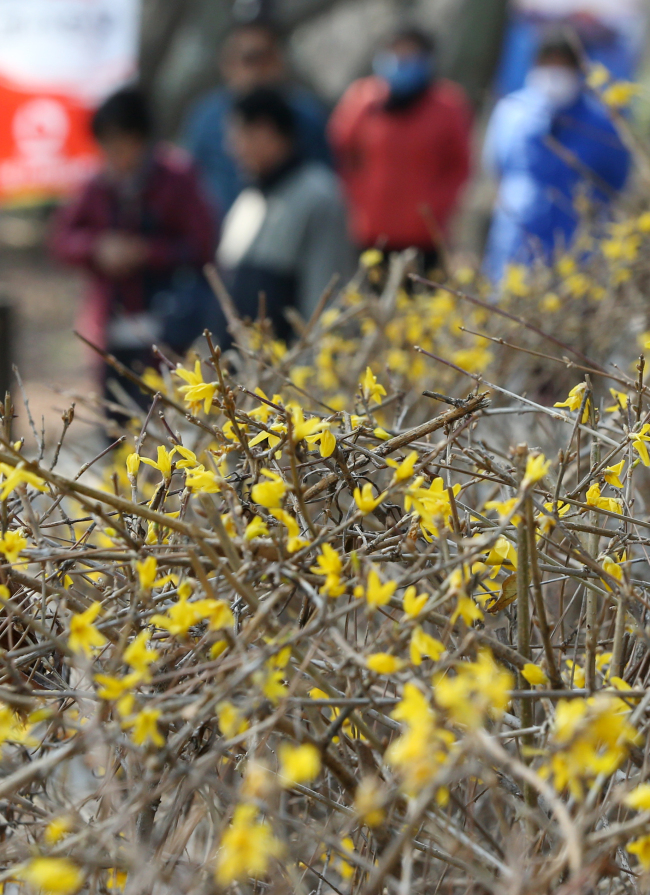Kim Mi-ra, a 58-year-old businesswoman in Seoul, has not worn a thick and heavy padded coat this winter. She has so far preferred a thin woolen overcoat or a light jacket.
“A heavy padded coat with muffler and gloves do not seem to be necessary this winter. I purchased a high-end goose down parka in October last year, but I only wore it once or twice,” said Kim.
Unlike previous years, the winter temperature has remained unusually warm this season.
 |
| The spring flower forsythia has prematurely come into bloom Monday at a public park in Ulsan amid the warm winter temperatures. (Yonhap) |
On Sunday, the highest temperature of southern city Busan reached nearly 17 degrees Celsius, and Jejudo Island marked 8.5 degrees Celsius. Seoul also saw highs of 11 degrees Celsius — 10 degrees higher than the typical average of 1.7 degrees Celsius — the Korea Meteorological Administration said.
The average temperature of December last year recorded 3.5 degrees Celsius, which is 2 degrees higher on-year. This is the highest winter average temperature since 1973, the KMA added.
The average temperature of November was 10.1 degrees Celsius, which was also 2.6 degrees higher on-year.
The unusually warm winter temperatures are suspected to be the impact of the “Super El Nino.” A prolonged warming in the Pacific Ocean surface temperature of about 0.5 degrees Celsius is referred to as “El Nino,” while an ocean surface temperature rise over 2.5 degrees Celsius is called “Super El Nino.”
“The weather usually gets colder as the continental high in the North expands while the North Pacific high weakens. The influence of the North Pacific high, however, still remains, due mainly to El Nino raising the temperature,” KMA officials said.
The El Nino effect this season is the strongest since the 1997-98 season. It is expected to continue into spring, they added.
The unusually high temperatures this winter have gradually affected public life and companies.
Sales of winter clothes, such as padded coats or outdoor jackets, have seen a sharp drop.
At Lotte Department Store, sales of outdoor jackets have dropped by 5.3 percent, while those of fur coats have plummeted by 8.6 percent.
Shinsegae Department Store has seen a similar pattern, as sales of outdoor clothes have fallen by 9.6 percent and winter accessories including gloves and scarves have declined by 9.3 percent.
The warm temperature also affected the agriculture sector.
Sangju in North Gyeongsang Province, where dried persimmons are widely grown, saw production of the fruit total only about 7,000 tons — 60 percent of the previous season. As a result, losses are estimated to top 43 billion won ($36.2 million), the city said.
Annual ice-related events have also been either called off or postponed.
Inje Icefish Festival and Hongcheongang Ggong Ggong Festival in Gangwon Province were canceled due to public safety concerns, the cities said. Inje had canceled the event last year, too.
In order to guarantee the safety of visitors, the thickness of the ice must be at least over 20 centimeters. Right now it is around 5 to 10 centimeters, they said.
The Yeongdong International Ice Climbing Competition slated for Jan. 23-24 in North Chungcheong Province is also likely to be postponed.
Similar events in Gapyeong, Gyeonggi Province, and Chengju, in North Chungcheong Province, have also been canceled.
While the El Nino effect will likely continue, the weather is expected to return to average temperature levels from Tuesday, with lows of minus 12 to 4 degrees Celsius anticipated across the country, the weather agency said.
By Lee Hyun-jeong (rene@heraldcorp.com)

